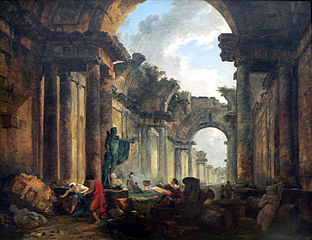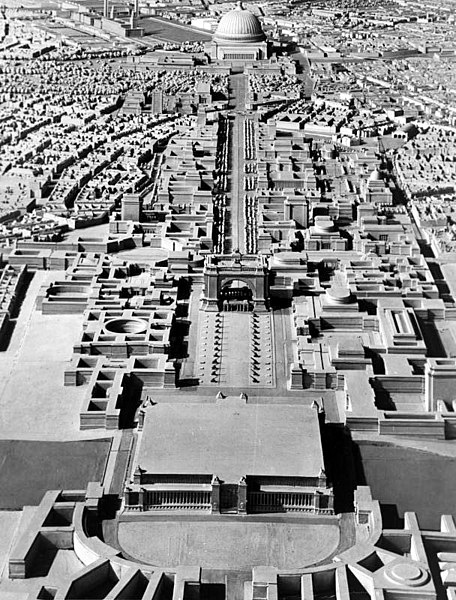Ruin value

폐허 가치는(독일어 발음: 루이넌베르트) 건물이 결국 붕괴되더라도, 어떠한 유지 보수 없이도 훨씬 더 오래 지속될 미적으로 만족스러운 폐허를 남기도록 디자인되어야 한다는 개념이다. 이 아이디어는 알베르트 슈페어(1905-1981)가 1936년 하계 올림픽을 계획하는 동안 선구적으로 제시했으며, “폐허 가치 이론”(디 루이넌베르트테오리)으로 출간되었다. 그 의도는 건물이 결국 붕괴되는 미래에만 국한된 것이 아니라, 오히려 그러한 건물들이 사용되는 동안에도 본질적으로 더 훌륭하게 디자인되고 더 웅장해 보일 것이라는 전제를 포함했다.
Ruin value (German: Ruinenwert) is the concept that a building be designed such that if it eventually collapsed, it would leave behind aesthetically pleasing ruins that would last far longer without any maintenance at all. The idea was pioneered by Albert Speer while planning for the 1936 Summer Olympics and published as “The Theory of Ruin Value” (Die Ruinenwerttheorie). The intention did not stretch only to the eventual collapse of the buildings, but rather assumed such buildings were inherently better designed and more imposing during their period of use.
히틀러 또한 이 아이디어를 지지하며, 그리스와 로마의 유적이 그 문명을 상징하는 것처럼 제3제국의 위대함을 상징하는 폐허를 남기려 했다.
The idea was supported by Hitler, who planned for such ruins to be a symbol of the greatness of the Third Reich, just as Greek and Roman ruins were symbolic of those civilizations.
다른 여러 문화권에서도 먼 미래를 내다보고 계획된 폐허가 될 구조물을 의도적으로 건설했다.
A number of other cultures have also planned for the far future and built structures which are intended to become planned ruins.
알베르트 슈페어와 폐허 가치 이론
Albert Speer and the theory of Ruin Value



폐허 가치 이론(독일어 발음: 루이넌베르트테오리)은 히틀러의 건축가인 알베르트 슈페어에 의해 고안되었다. 이 이론은 “자연적인” 재료를 사용하고 철제 거더(대들보)를 회피하는 것에 관한 고트프리트 젬퍼(1803-1879)의 견해를 확장한 것이다.
The theory of Ruin Value (Gr. Ruinenwerttheorie) was conceived by Hitler’s architect Albert Speer. The theory was an extension of Gottfried Semper’s views about using “natural” materials and the avoidance of iron girders.
슈페어의 회고록은 로마 제국 건축과 관련하여 나치 국가 건축에 관한 히틀러의 생각을 드러낸다:
Speer’s memoirs reveal Hitler’s thoughts about Nazi state architecture in relation to Roman imperial architecture:
히틀러는 자신의 건축 목적이 자신의 시대와 그 정신을 후대에 전하는 것이라고 말하기를 좋아했다. 궁극적으로, 역사의 위대한 시대를 사람들에게 상기시키기 위해 남아 있는 것은 기념비적인 건축물뿐이라고, 그는 말했다. 로마 제국의 황제들에게 남은 것은 무엇인가? 만약 그들의 건물이 아니라면, 오늘날에도 여전히 그들에 대한 증거를 제공할 수 있는 것은 무엇인가? […] 그래서, 오늘날 로마 제국의 건축물은 무솔리니가 자신의 국민에게 근대 제국에 대한 아이디어를 불어넣고 싶을 때 로마의 영웅적인 정신을 언급할 수 있게 해주었다. 우리의 건물은 또한 독일의 미래 세대의 양심에 말을 걸어야 한다. 이러한 주장과 함께, 히틀러는 또한 내구성이 강한 건축물의 가치를 강조했다.
Hitler liked to say that the purpose of his building was to transmit his time and its spirit to posterity. Ultimately, all that remained to remind men of the great epochs of history was their monumental architecture, he remarked. What then remained of the emperors of the Roman Empire? What would still give evidence of them today, if not their buildings […] So, today the buildings of the Roman empire could enable Mussolini to refer to the heroic spirit of Rome when he wanted to inspire his people with the idea of a modern imperium. Our buildings must also speak to the conscience of future generations of Germans. With this argument Hitler also underscored the value of a durable kind of construction.
그런 이유로 히틀러는 미래 세대에게 “전통으로의 다리”를 제공하기 위해 기념비적인 정당 건물을 지을 때 철제 거더와 철근 콘크리트 같은 현대적인 “익명의” 재료는 피해야 한다는 슈페어의 권고를 승인했다. 왜냐하면 그러한 재료들은 가능한 한 미적으로 용인되는 폐허를 만들어내지 못할 것이기 때문이다. 이렇게 하여 제국에서 정치적으로 가장 중요한 건물들은 수천 년 후 폐허가 된 후에도, 어느 정도, 로마 모델을 닮도록 의도되었다.
Hitler accordingly approved Speer’s recommendation that, in order to provide a “bridge to tradition” to future generations, modern “anonymous” materials such as steel girders and ferroconcrete should be avoided in the construction of monumental party buildings, since such materials would not produce aesthetically acceptable ruins like those wherever possible. Thus the most politically significant buildings of the Reich were intended, to some extent, even after falling into ruins after thousands of years, resemble their Roman models.

슈페어는 1937년 4개년 계획에서 「철 아닌 돌」이라는 기고문을 통해 이 문제에 대한 자신의 견해를 밝혔는데, 여기서 그는 파르테논 신전 사진과 함께 다음과 같은 설명을 실었다: “고대의 석조 건물은 오늘날의 상태 그대로 자연 건설 재료의 영속성을 보여준다.” 나중에, 현대 건물이 50년 이상 지속되는 경우가 드물다고 말한 후, 그는 계속해서 말한다: “이집트와 로마의 오래된 석조 건물은 강대국의 과거를 증명하는 강력한 건축적 증거로 오늘날까지도 여전히 서 있는데, 건물들이 폐허가 된 것은 종종 인간의 파괴 욕망 때문이었다.” 히틀러는 슈페어가 담쟁이 덩굴로 뒤덮인 폐허가 된 하웁트트리뷔너(경기장 좌석)의 스케치를 보여준 뒤에 슈페어의 “폐허 가치 법”(독일어 발음: 루이넌게제트)을 승인했다. 이 드로잉은 히틀러를 기쁘게 했지만 그의 측근들을 분개시켰다.
Speer expressed his views on the matter in the Four Year Plan of 1937 in his contribution Stone not Iron in which he published a photograph of the Parthenon with the subscript: “The stone buildings of antiquity demonstrate in their condition today the permanence of natural building materials.” Later, after saying modern buildings rarely last more than fifty years, he continues: “The ages-old stone buildings of the Egyptians and the Romans still stand today as powerful architectural proofs of the past of great nations, buildings which are often ruins only because man’s lust for destruction has made them such.” Hitler approved Speer’s “Law of Ruin Value” (Gr. Ruinengesetz) after Speer had shown him a sketch of the Haupttribüne as an ivy-covered ruin. The drawing pleased Hitler but scandalized his entourage.
대부분의 이러한 계획된 건물들은 결코 지어지지 않았으며, 심지어 지어진 건물조차도, 의도한 재료 대신에, 값싼 콘크리트로 지어지는 경우가 많았다. 오늘날, 그 건물들은 대부분 낭만적이지 않은 폐허가 되어 들판에 방치되거나, 철거되었다.
Most of these planned buildings were never constructed, and even those that were, were often constructed out of cheap concrete, instead of the materials intended. Today, they mostly either lie in unromantic ruin in fields, or have been demolished.
현대의 계획된 폐허
Modern planned ruins
의도된 폐허의 보다 현대적인 예로는 (미국) 유카산 핵 폐기물 처리장을 위한 계획된 경고 표지판이 있다. 이 표지판들은 1만 년 동안 견디면서도 미래 세대에 지속적인 (부정적인) 인상을 전달하도록 의도되었다: “출입 금지. 여기를 파지 말 것.”
A more modern example of intended ruins are the planned warning signs for the proposed nuclear waste dump at Yucca Mountain, which are intended to endure for 10,000 years, and yet still convey an enduring (if negative) impression on future generations: “Keep out. Don’t dig here.“
소설 속 계획된 폐허
Planned ruins in fiction
계획된 폐허는 SF에서 흔한 주제이며, 종종 사회가 수천 년에 걸쳐 서서히 붕괴되도록 디자인된 폐허 속에 메시지나 작동하는 기계를 남겨두는 모습으로 묘사된다.
Planned ruins are a common theme in science fiction, where societies are often depicted as leaving messages, or working machines, buried within ruins designed to erode over millennia.
- 출처 : 「Ruin value」, Wikipedia(en), 2022.10.26.